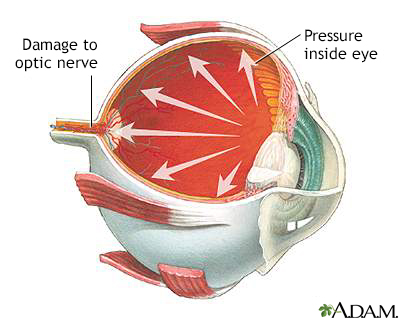Pregnancy SmartSiteTM
Open-angle glaucoma; Chronic glaucoma; Chronic open-angle glaucoma; Primary open-angle glaucoma; Closed-angle glaucoma; Narrow-angle glaucoma; Angle-closure glaucoma; Acute glaucoma; Secondary glaucoma; Congenital glaucoma; Vision loss - glaucoma DefinitionGlaucoma is a group of eye conditions that can damage the optic nerve. This nerve sends the images you see to your brain. Most often, optic nerve damage is caused by increased pressure in the eye. This is called intraocular pressure. CausesGlaucoma is the second most common cause of blindness in the United States. There are four major types of glaucoma:
The front part of the eye is filled with a clear fluid called aqueous humor. This fluid is made in an area behind the colored part of the eye (iris). It leaves the eye through channels where the iris and cornea meet. This area is called the anterior chamber angle, or the angle. The cornea is the clear covering on the front of the eye that is in front of the iris, pupil, and angle.  Anything that slows or blocks the flow of this fluid will cause pressure to build up in the eye.
Open-angle glaucoma is the most common type of glaucoma.
Closed-angle glaucoma occurs when the fluid is suddenly blocked and cannot flow out of the eye. This causes a quick, severe rise in eye pressure.
Secondary glaucoma occurs due to a known cause. Both open- and closed-angle glaucoma can be secondary when caused by something known. Causes include:
Congenital glaucoma occurs in babies.
SymptomsOPEN-ANGLE GLAUCOMA
ANGLE-CLOSURE GLAUCOMA Symptoms may come and go at first, or steadily become worse. You may notice:
CONGENITAL GLAUCOMA Symptoms are most often noticed when the child is a few months old.
SECONDARY GLAUCOMA
Exams and TestsThe only way to diagnose glaucoma is by having a complete eye exam.
 Eye pressure is different at different times of the day. Eye pressure can even be normal in some people with glaucoma. So you may need other tests to confirm glaucoma. They may include:
 TreatmentThe goal of treatment is to reduce your eye pressure. Treatment depends on the type of glaucoma that you have. OPEN-ANGLE GLAUCOMA
If drops alone do not work, you may need other treatment:
ACUTE ANGLE GLAUCOMA An acute angle-closure attack is a medical emergency. You can become blind in a few days if you are not treated.
CONGENITAL GLAUCOMA
SECONDARY GLAUCOMA If you have secondary glaucoma, treating the cause may help your symptoms go away. Other treatments also may be needed. Outlook (Prognosis)Open-angle glaucoma cannot be cured. You can manage it and keep your sight by following your provider's directions. Closed-angle glaucoma is a medical emergency. You need treatment right away to save your vision. Babies with congenital glaucoma usually do well when surgery is done early. How you do with secondary glaucoma depends on what is causing the condition. When to Contact a Medical ProfessionalIf you have severe eye pain or a sudden loss of vision, get immediate medical help. These may be signs of closed-angle glaucoma. PreventionYou cannot prevent open-angle glaucoma. Most people have no symptoms. But you can help prevent vision loss.
If you are at risk for closed-angle glaucoma, your provider may recommend treatment before you have an attack to help prevent eye damage and vision loss. References2019 exceptional surveillance of glaucoma: diagnosis and management (NICE guideline NG81) [Internet]. London: National Institute for Health and Care Excellence (UK); 2019 Sep 12. PMID: 31909934 pubmed.ncbi.nlm.nih.gov/31909934/. Gedde SJ, Lind JT, Wright MM, et al. American Academy of Ophthalmology Preferred Practice Pattern Glaucoma Panel. primary open-angle glaucoma suspect preferred practice pattern. Ophthalmology. 2021;128(1):P151-P192. PMID: 34933743 pubmed.ncbi.nlm.nih.gov/34933743/. McMillan BD, Gross RL. Current medical management of glaucoma. In: Yanoff M, Duker JS, eds. Ophthalmology. 6th ed. Philadelphia, PA: Elsevier; 2023:chap 10.22. Hood DC, La Bruna S, Tsamis E, et al. Detecting glaucoma with only OCT: implications for the clinic, research, screening, and AI development. Prog Retin Eye Res. 2022;90:101052. PMID: 35216894 pubmed.ncbi.nlm.nih.gov/35216894/. Jampel HD, Mahjoub H. Evidence-based medicine in glaucoma. In: Yanoff M, Duker JS, eds. Ophthalmology. 6th ed. Philadelphia, PA: Elsevier; 2023:chap 10.32. Madu A, Rhee DJ. Which therapy to use in glaucoma. In: Yanoff M, Duker JS, eds. Ophthalmology. 5th ed. Philadelphia, PA: Elsevier; 2019:chap 10.23. Moyer VA; U.S. Preventive Services Task Force. Screening for glaucoma: U.S. Preventive Services Task Force Recommendation Statement. Ann Intern Med. 2013;159(7):484-489. PMID: 24325017 pubmed.ncbi.nlm.nih.gov/24325017/. Stein JD, Khawaja AP, Weizer JS. Glaucoma in adults-screening, diagnosis, and management: a review. JAMA. 2021;325(2):164-174. PMID: 33433580 pubmed.ncbi.nlm.nih.gov/33433580/. | |
| |
Review Date: 8/22/2022 Reviewed By: Franklin W. Lusby, MD, Ophthalmologist, Lusby Vision Institute, La Jolla, CA. Internal review and update on 07/23/2023 by David C. Dugdale, MD, Medical Director, Brenda Conaway, Editorial Director, and the A.D.A.M. Editorial team. The information provided herein should not be used during any medical emergency or for the diagnosis or treatment of any medical condition. A licensed medical professional should be consulted for diagnosis and treatment of any and all medical conditions. Links to other sites are provided for information only -- they do not constitute endorsements of those other sites. No warranty of any kind, either expressed or implied, is made as to the accuracy, reliability, timeliness, or correctness of any translations made by a third-party service of the information provided herein into any other language. © 1997- A.D.A.M., a business unit of Ebix, Inc. Any duplication or distribution of the information contained herein is strictly prohibited. | |

 Eye
Eye Slit-lamp exam
Slit-lamp exam Visual field test
Visual field test Glaucoma
Glaucoma Optic nerve
Optic nerve Applanation tonome...
Applanation tonome...
